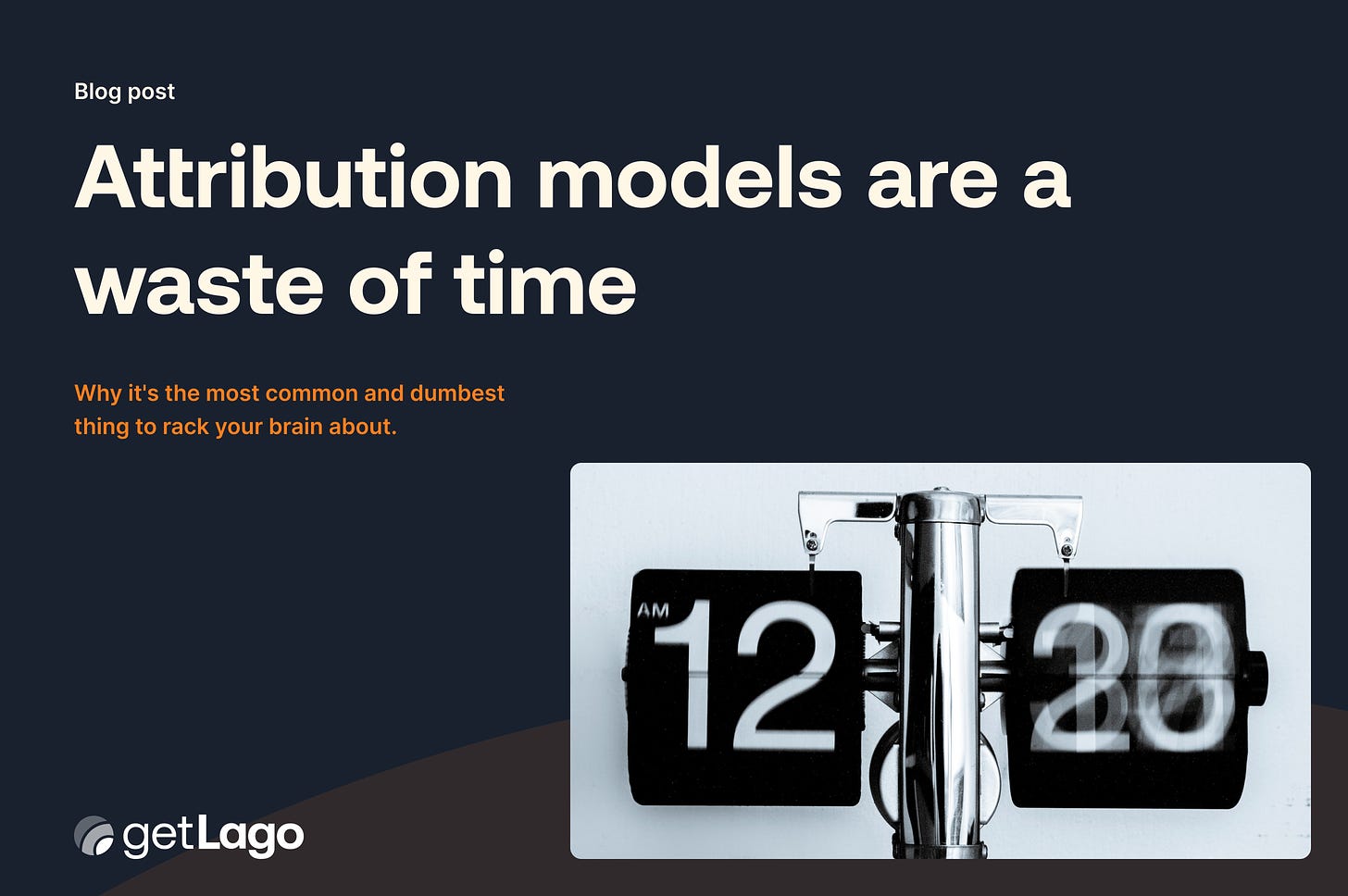Attribution models are a waste of time
Why it's the most common and dumbest thing to rack your brain about.
I’ve seen Growth marketers worry about lots of different things.
Attribution models are both the most common and the dumbest thing to rack your brain about.
I’ve spent sleepless nights on this topic, and if I were to do it again, this challenge would be solved in 5 minutes. Let me explain how and why.
TL;DR
Get it out of your system. Right. Now. You, in 99% of cases, don’t need a custom attribution model.
At least, not a more sophisticated one than ‘first’ or ‘last touch’.
Longer version
What exactly are we talking about?
Attribution models are a way to ‘attribute’ a conversion (usually a sign-up or a sale) to one or several marketing channels: a TV campaign, a Facebook ads campaign, etc.
For instance, if one of your leads interacts with a Facebook ad, then with a Google adwords ad, then talks to a Sales executive during an event, and finally signs up after clicking on a Linkedin Ad, how do you determine the influence of each channel on the sign-up?
Is it 100% Facebook? (First touch)
Is it Linkedin? (Last touch)
Is it equally distributed? (¼ for each touchpoint)
And the list can go on.
All this really matters because you would like to ensure that the ROI of each channel is under control, which is the #1 job of whoever is in charge of go-to-market.
You have 2 choices:
Option 1
Spend months working on it, mobilizing tech, data, and business resources, postponing your growth campaigns in the waiting of striking the perfect model.
Let’s say you spend 3 months going through this step, with a full-stack developer, a data scientist and 20% of your very own time:
Deciding on an attribution model at the concept level. Is there a completely rational way to choose between a W-shape model and a distributed one? Or should data scientists spend weeks on elaborating a sophisticated model that the main users (Growth marketers) would not understand?
Making sure you track every touchpoint before the lead signs-up
It might be easier to do this for online touchpoints, but what about offline touchpoints, that usually cost the most?
Centralizing tracked data into a single place: there are countless ways to do it, most of them require engineering
Performing ‘identity resolution’: how do you even know that the Jane who interacted with your Twitter company account (through her personal account), is the same Jane who contacted your support team through Zendesk (through her professional email) and who downloaded your app (but did not log in yet)?
Unless you have a tool such as Lago, ‘identity resolution’ is hell: you need a data engineer to implement this, and each time you add a new ‘data source’ (any Growth Marketing tool is one), your engineering team will need to rework how they perform identity resolution.Making the analysis accessible to marketing execs: they are not data experts, but should be able to identify takeaways that will serve business goals in a few minutes
✅ Pros:
You would definitely have more data to consult at your fingertips.
You would have explored data modelings, improved your tracking stack
❌ Cons:
You’ll have to strike a balance between:
Simple model: probably less accurate, but understandable by everyone
Custom and sophisticated model: potentially more accurate, but less understandable by everyone in the organization.
The main question is: can your junior marketer managing the day-to-day of your campaigns draw conclusions from your custom attribution analysis?
What I’ve witnessed in most cases, is that you might very well never get a reliable enough answer, or one that is perceived as such (in that case, Marketing teams keep using a simple attribution model: first or last touch)
You would have most likely postponed your campaigns hoping to be more precise and yet actually lost many leads in the process
Option 2
a) Keep your global Cost of Acquisition (CAC) under control, with a simple ratio: Number of new conversions / Global acquisition spend.
b) Identify ‘no-brainer’ actions.
Actions are needed, and that no analysis or complex attribution model would deprioritize.
There are so many more that you might realize at first sight, such as:
How does your first touch interactions with leads look like? Can it be improved? I’m thinking: how hard have you worked on your landing pages’ conversion rates? On your cold emails copy? On the SEO ranking of your most viewed pages?
How about the last touch? Have you tweaked your sales script and tested it? Have you tested different copies of your Adwords ad?
What’s the satisfaction rate of people in contact with your Sales team at the different stages of the funnel?
If you’re organizing events, what’s the NPS of attendees?
Do some of your new users drop during onboarding and never come back? Have you tried to fix this?
What does your activation rate look like after onboarding? Have you defined it and are you monitoring and improving it over time?
✅ Pros:
You can address no-brainers, allocate efforts on direct and high-impact projects, while keeping your global cost of acquisition under control. I.e., you know you don’t spend more than X€ to acquire a new customer, regardless of which channel contributes most, and that’s ‘good enough’ information for you.
❌ Cons:
You don’t have an exact or sophisticated attribution model, and visualization of leads’ journey.
To summarize, 99% of the time, I’d go for Option 2 as:
The most important indicator is under control: your global CAC
You make the best allocation of resources: no-brainers with high predictable impact, vs conceptual brainstorming with low predictable impact
Should I be more nuanced? In general, as everyone, I have room for improvement, however, on this specific topic, I really don’t think so 😉.




